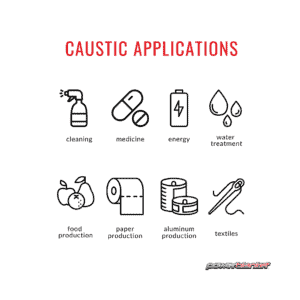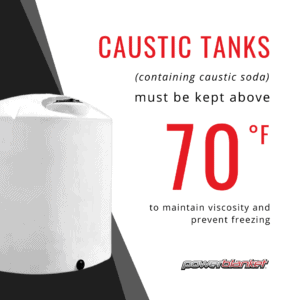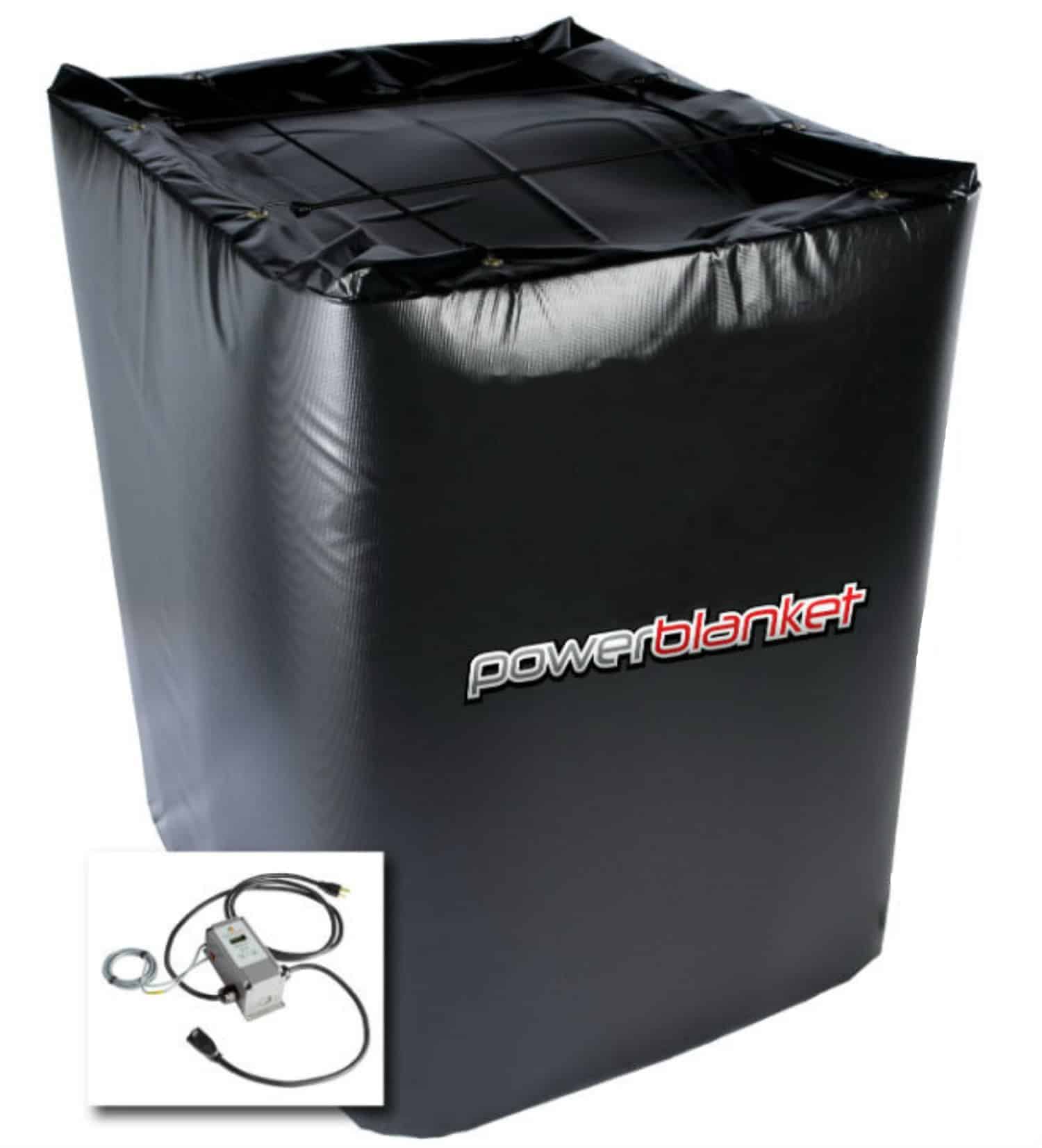Caustics are substances that burn or corrode via chemical reactions. Most commonly, “caustics” or “caustic tanks” refer to the use and storage of sodium hydroxide (more commonly referred to as caustic soda). This substance requires a heating solution to stay viscous at room temperature. Caustic potash (potassium hydroxide) and caustic lime (calcium oxide) are other commonly used caustic substances. Each of these chemicals has a myriad of industrial applications, including cleaning, chemical pulping, food production, soap manufacturing, and agriculture.
With customizable heating solutions for any size caustic tank, Powerblanket takes the guesswork out of maintaining proper storage temperatures. Powerblanket heating solutions offer precise temperature control and even heating distribution to keep your caustic substances in optimal condition.
The Many Applications of Caustics
When used safely and correctly, caustics can do some pretty remarkable things. These substances have a lengthy list of common applications. Let’s take a look at a few of the more common uses of caustic substances:

Cleaning & Disinfecting Products
Caustic chemicals are used to create soaps and detergents used in homes and businesses. Caustic soda (sodium hydroxide) is also used as one of the main ingredients in the production of chlorine bleach. Additionally, when used in drain cleaners, caustic substances convert fats that clog pipes into soap which dissolves in water.
Medicine
Caustics are used to manufacture several medicines and pharmaceutical products, including aspirin, anticoagulants, and cholesterol-reducing medications.
Energy
In the energy sector, caustics are used in fuel cell production. Fuel cells work like batteries to cleanly and efficiently produce electricity for a range of applications, including transportation, materials handling, and stationary, portable, and emergency backup power applications.
Water Treatment
Municipal water treatment facilities use caustics to control water acidity and to help remove heavy metals from water. Sodium hydroxide is also used to produce sodium hypochlorite, a water disinfectant.
Food Production
Caustic substances are used in several food processing applications, such as curing and softening foods like olives or helping to brown pretzels and bagels. Caustics are also used to remove skins from fruits and vegetables for packaging and canning.
Paper Products
In many paper-making processes, wood is treated with a solution containing caustic chemicals. This solution dissolves most of the unwanted material in the wood, leaving behind the cellulose, which forms the basis of paper. During recycling, sodium hydroxide is used to separate ink from paper so the paper fibers to be reused.
Aluminum Processing
Caustics are used to extract alumina from natural minerals. Alumina is used to make aluminum and aluminum products, including cans, beer kegs, foil, kitchen utensils, building materials, and airplane parts.
Textiles
Caustics are a key player in the manufacturing of rayon and spandex. Additionally, these substances are used to create dyes, process cotton fabric, and in laundering and bleaching.
Common Caustic Chemicals
Caustic Potash (Potassium hydroxide)
Caustic Potash, or Potassium Hydroxide comes in the form of an odorless, white solid, typically flakes or pellets.
One of the most common uses of this substance is in adjusting the pH levels of water at water treatment plants. Caustic potash is also used to manufacture soaps and shaving creams, in the creation of liquid fertilizers, and in food production.
Storage:
Because potassium hydroxide quickly absorbs moisture from the air, it must be kept in a cool, dry environment. Tightly-sealed caustic tanks kept in a well-ventilated area are recommended.
Caustic Lime (Calcium Oxide)
Like caustic potash, Caustic Lime (Calcium Oxide) is a white solid at room temperature. Some of the most common uses of this substance are in making porcelain and glass, purifying sugar, in water softeners, and in lowering the acidity of soil.
Storage:
Calcium oxide should be kept in air-tight storage containers or caustic tanks to prevent contact with carbon dioxide and moisture in the air.
Caustic Soda (Sodium Hydroxide)
Caustic soda, or Sodium hydroxide, is a liquid at room temperature and is used as both a catalyst and cleaner in several industries, including pulp and paper, chemical processing, oil refining, and textiles.
Storing Caustic Soda- Temperature Matters!
Caustic soda should be kept in caustic tanks made from HDPE, XLPE, FRP, carbon steel or titanium. Here’s where things get a little tricky: depending on the concentration, sodium hydroxide’s freezing point isn’t too far below room temperature. This means that storage tanks should be kept above 70°F to prevent freezing and to maintain viscosity.
Caustic Tank Heating
Maintaining caustic tank temperatures often requires a simple heating solution. Here are a few of the most common options:
- Heating Tape: Despite its name, heat tape isn’t an adhesive at all. Rather, it’s a type of electrical cable that, when wrapped around a caustic tank, applies a controlled amount of heat to prevent freezing.
- Steam Coils: Steam coils use moisture in the air to create heat. This method heats the air surrounding the storage tanks to help keep chemicals at optimal temperatures.
- Internal heating via heat exchanger: For this solution, a heat exchanger is installed within the caustic tank and circulates heat from the ambient air to the chemicals within the tank.
Heating Solutions from Powerblanket
Caustic soda requires a careful hand when it comes to heating. As stated, temperatures should be kept above 70. However, when temperatures get too hot, the chemical will start to degrade. Powerblanket offers precise, even heating solutions without any harmful “hot spots” that could damage the product. What’s more, each product is fully customizable. For more info on caustic tank heating solutions from Powerblanket, give us a call at (888) 316-6324.
Frequently Asked Questions
What are caustic chemicals?
Caustic chemicals are substances that can burn or corrode materials, including skin and mucous membranes, through chemical reactions, with sodium hydroxide being a common example used in various industrial applications.
What does caustic do to your skin?
Contact with caustic substances can cause skin irritation or severe burns, depending on the concentration and duration of exposure.
Is caustic the same as bleach?
While caustic substances like sodium hydroxide are used in the production of bleach, they are not the same; bleach is a solution of sodium hypochlorite, which is made by reacting chlorine with sodium hydroxide.
Is caustic toxic?
Caustic substances can be toxic if ingested, causing severe burns to the mouth, esophagus, and stomach, potentially leading to serious infections if perforations occur.
Powerblanket's custom tank heaters provide freeze protection, making your business more sustainable and efficient.








